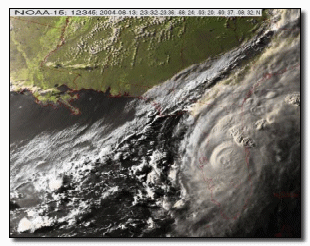 Many water and wastewater operators have implemented private wireless telemetry (SCADA)
systems to monitor and control their pumps, valves and lift stations. They believed the
high level of performance and reliability required dictated that they "roll their own,"
and not depend on other services. Several communities in Hurricane Charley's path found
out that cellular-based data transmission not only is up to the task, but outperforms
traditional methods, and costs less. Many water and wastewater operators have implemented private wireless telemetry (SCADA)
systems to monitor and control their pumps, valves and lift stations. They believed the
high level of performance and reliability required dictated that they "roll their own,"
and not depend on other services. Several communities in Hurricane Charley's path found
out that cellular-based data transmission not only is up to the task, but outperforms
traditional methods, and costs less.
Situation
- Sites in direct path of major hurricane
- Tremendous cellular call volume ahead of and behind the storm
- Extended power outages
Result
“There's no way anyone could afford to build
and operate a private wireless network to the standards
of the major wireless carriers, not to mention that a
cellular SCADA system is less expensive to own and
operate than any traditional SCADA system that we've
seen. Let them do what they do best, and we will do
what we do best, operate a water utility. It works
better and is one less problem we have to deal with,”
says Robert Bolton of Vero Beach Florida Utilities.
|
Digital cellular- based SCADA systems are rapidly gaining acceptance in the water and
wastewater utility industry. Hundreds of systems are now deployed and many others
are testing the new technology. Unlike the older "cellular voice auto dialers,"
the new cellular SCADA systems utilize control channel cellular data services, or
third-generation (3G) cellular data services, to transmit telemetry data to and
from pumping stations, lift stations, and field instrumentation sites. While
attracting many customers due to their ease of use and low costs, customers wonder
"How will the systems stand up during a natural disaster? Will the data still get
through when everyone is trying to make cell calls?" Friday, August 13, 2004
hurricane Charley came ashore on the southwest coast of Florida and tore a path
diagonally through the state. In Charley's path were numerous utilities with
cellular SCADA units deployed.
Tampa Evacuated but Spared the Worst
Hillsborough County Utilities serves the Tampa Bay area, and has been testing control
channel and 3G cellular SCADA units for some time. An evacuation of the coastal area
was ordered, since Charley was predicted to make a direct hit. MISSION Communications
of Atlanta, Georgia, the first supplier of the new cellular SCADA systems to the
water industry, was in contact with Hillsborough County employees preparing for the
worst. "MISSION was helping the customer rearrange their alarm callout list and turn
off certain alarms so as to not swamp the field personnel with unnecessary calls during
the storm," says John Collings, President of MISSION. "One of the advantages of our
system is that data can be accessed securely from almost anywhere and suppliers such
as MISSION can help administer a customer's system during extraordinary events such
as this."
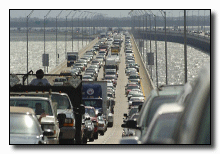
One of the Hillsborough units is located at the intersection of two major highways
near the Tampa International Airport. This RTU transmits site level and pump status
continuously. Throughout the evacuation, the two local highways near the site were
jammed. Even with the thousands of on-going cellular phone calls being served near the
site, MISSION recorded not one delay or data disconnect. The real-time data units send
data as pumps turn on and off and as wet well levels rise and fall. “You can
literally watch what is happening at a pump station real-time,” says Collings.
“This particular pump station is extremely active due to its shallow well and
high flow. Frankly, we would have anticipated a few reconnects due to its high data
transmit rate and the proximity to the highway, but it performed flawlessly.”
Capacity and Redundancy
The latest cellular-SCADA units transmit tiny amounts of data compared to an ongoing
voice conversation. The cellular system fills in the millisecond gaps in voice conversations
with data from field units. If there is even a short delay of voice data, the caller
will experience garbled voice or a dropped call. With packetized data, a slowdown is
an inconvenience but the data still moves through the system. Because a cellular system
is designed for voice, where each call transmits thousands of bytes per second, telemetry
data sent at a rate of tens-of-bytes per minute can easily find spare capacity (there's
always room for a couple grains of sand in a bucket full of rocks). Also, since most
locations are covered by multiple cell sites, if a site goes down the radio automatically
tunes to the frequencies used by another nearby tower and the connection continues as
if nothing had happened. In a voice call this is analogous to a car driving out of
the coverage area of one cell into the coverage area of the next. Handoffs like this
happen flawlessly, billions of times a day.
Below is a connection history of the MISSION SCADA unit during the evacuation:
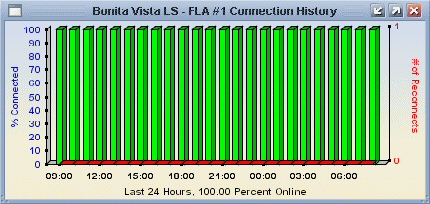
It shows there were no data disconnects (no data was dropped and had to be retried, no
packets were received out of sequence, and none were delayed more than eight seconds due
to insufficient cell site capacity).
Shown here is graph of some of the data that was transmitted during the time of the
storm. Power to much of the area was shut off by officials in anticipation of Charley's
arrival. Since the MISSION RTU powers both the radio and the wet well level sensor at this
site using its battery, it continued to transmit the level as winds gusted overhead.

At the time power was restored ten hours later, a spike in the wet well level can be seen.
This is due to power being restored to other pump stations which feed into the site.
Cellular Response in an Emergency
Cellular carriers are keenly aware that during, and after, catastrophic events, many
emergency services depend on their networks for vital, even life-saving communications.
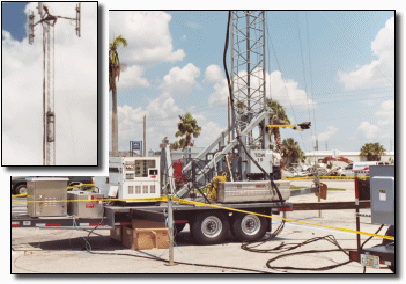 When disasters such as Charley occur, the carriers are ready to respond quickly, with the
full strength that a nationwide, Fortune 500 company can muster. Most carriers have regional
emergency response crews with portable generators, mobile towers, and other system-restoral
equipment on standby at all times --
this is similar to water utilities assisting other utilities with their standby generators
or by-pass pumps. When disasters such as Charley occur, the carriers are ready to respond quickly, with the
full strength that a nationwide, Fortune 500 company can muster. Most carriers have regional
emergency response crews with portable generators, mobile towers, and other system-restoral
equipment on standby at all times --
this is similar to water utilities assisting other utilities with their standby generators
or by-pass pumps.
When a disaster can be “forecast,” such as a hurricane, these crews move portable,
temporary cell sites called “COWs” (Cellular On Wheels) or “COLTs” (Cellular
On Light Trucks) to staging areas in preparation for the event. As soon as the storm has passed,
this equipment can be quickly moved into affected areas to provide service and add capacity.
Port Charlotte Site Takes a Direct Hit
Though still months from their scheduled roll-out of cellular SCADA units, Charlotte County
Utilities had cellular SCADA units of both types deployed in the Port Charlotte area. The units
transmitted power failure messages just before 5 PM. During the passage of the eye, the 3G
cellular units began reconnecting. Some reconnects took as long as 11 minutes. At 5:20 and 5:24
PM MISSION “pinged” one of the control channel cellular units for status data. The
units answered back on both occasions. For the next six hours, Charley moved through Florida.
Though there were numerous temporary outages, all systems returned to normal by midnight and survived
the storm.
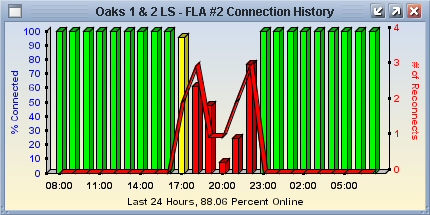
One Less Problem to Deal With
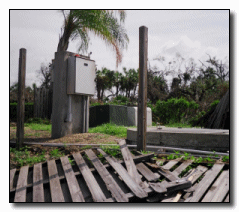
The success of these cellular SCADA systems is best summed up by a comment made from Robert Bolton
of Vero Beach Florida Utilities. “There's no way anyone could afford to build and operate a
private wireless network to the standards that the likes of AT&T, Nextel, Sprint and Verizon
can. Now that these types of services are available why should they? Not to mention that a cellular
SCADA system is less expensive to own and operate than any traditional SCADA system that we've seen.
Let them do what they do best, and we will do what we do best, operate a water utility. It works
better and is one less problem we have to deal with.” John Collings from MISSION Communications
says, “While we are extremely pleased with the networks performance through this devastating
storm, we have learned we need to equip units in hurricane prone areas with 5-day batteries instead
of 2-days, and to be thankful they don't occur more often.”
|
